This Thursday, the United States Army will receive a new artillery vehicle, the M109A7 PIM or Paladin Integrated Management, a 155mm self-propelled howitzer.
With the previous cancellations of the two bottom-up next generation self-propelled howitzer programs – the XM 2001 Crusader and XM1203 Non-Line-of-Sight Cannon – the M109A7 will be the U.S. Army’s first new artillery piece in twenty years. The M109A7 constitutes a, “new approach to acquisition, in which expensive, ambitious, all-new designs give way to incremental but still substantial changes to existing platforms,”according to Sydney Freedberg over at Breaking Defense.
From the outside, the M109A7 PIM does not look different from its predecessor the M109A6, or in fact the original M109 self-propelled gun first introduced in the 1960s. However, as Freedberg notes : “In fact, PIM is more like surgically transplanting someone’s head onto a new body: It takes the old gun turret and installs it on an all-new chassis.”
Mark Signorelli, head of combat vehicle programs at BAE Systems succinctly summarized why the M109A7 is more than just an upgrade of an existing weapon system:
“M109A6 built a new turret and put it on the old chassis. M109A7 put a new chassis under the A6 turret, with a few upgrades to the turret, and effectively in two steps the Army built a new howitzer.”
However, the vehicle’s cannon will remain unchanged, despite a new electronic gun drive system – which had been developed for the cancelled Non-Line-of-Sight Cannon – and an improved automated loader. The M109A7’s main 155/39 mm gun can fire four rounds per-minute, including M982 Excalibur precision munition, which boasts a maximum range of 40 km.
What makes the army’s new artillery vehicle unique in comparison to other weapon procurement programs is its cost-effectiveness. “The M109A7 shares engine, transmission, tracks and some other components with the Bradley infantry fighting vehicle. Such commonality allows to reduce production, operating and maintenance costs,” according to military-today.com.
The U.S. Army plans to acquire 580 sets of new artillery vehicles – one set includes a M109A7 along with the M992A3 Carrier Ammunition, Tracked (CAT) – and are expected to remain in service until 2050. Deliveries will begin in 2015, however, full-scale production will only commence in 2017.
The slow return of conventional and hybrid warfare over the last couple of years has shown that artillery will remain an important asset for future military campaign. For example, any conventional war scenario on the Korean peninsula, would be characterized by massive and devastating conventional artillery fire. As Sydney Freedberg notes:
An artillery piece like Paladin may seem archaic in an era of smart bombs and armed drones, when the Air Force is developing a new stealth bomber, the Navy is testing a laser in the Persian Gulf, and the Army itself is considering creating cruise missile batteries. Indeed, US troops in Afghanistan and Iraq relied less on artillery than airstrikes and attack helicopters. But that reliance presumed the aircraft could get through. Against a high-tech foe, one with sophisticated surface-to-air missiles and jamming to drive off American aircraft or decoy their weapons, old-fashioned cannon might be the only big guns a ground commander could rely on.
However, one of the questions left unanswered is whether the M109A7 will truly be able to live up to its peer competitors (e.g., the Panzerhaupitze 2000) in other armies across the world.
































